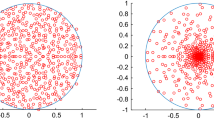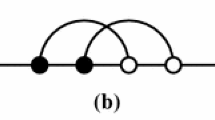Consider a d × d matrix M whose rows are independent, centered, nondegenerate Gaussian vectors ξ 1,…,ξ d with covariance matrices Σ1,…,Σ d . Denote by ε i the dispersion ellipsoid of \( {\xi_{\mathrm{i}}}:{\varepsilon_i}=\left\{ {\mathbf{x}\in {{\mathbb{R}}^d}:{{\mathbf{x}}^{\top }}\sum\nolimits_i^{-1 } {\mathbf{x}\leq 1} } \right\} \). We show that
where V d (·,…,·) denotes the mixed volume. We also generalize this result to the case of rectangular matrices. As a direct corollary, we get an analytic expression for the mixed volume of d arbitrary ellipsoids in ℝd.
As another application, we consider a smooth, centered, nondegenerate Gaussian random field X = (X 1,…,X k )⊤ : ℝd → ℝk. Using the Kac-Rice formula, we obtain a geometric interpretation of the intensity of zeros of X in terms of the mixed volume of dispersion ellipsoids of the gradients of \( {{{{X_i}}} \left/ {{\sqrt{{\mathbf{Var}{X_i}}}}} \right.} \). This relates zero sets of equations to mixed volumes in a way which is reminiscent of the well-known Bernstein theorem about the number of solutions of a typical system of algebraic equations.
Similar content being viewed by others
References
J. M. Azaïs and M. Wschebor, Level Sets and Extrema of Random Processes and Fields, Wiley (2009).
A. Barvinok, “Computing mixed discriminants, mixed volumes, and permanents,” Discrete Comput. Geom., 18, 205–237 (1997).
D. N. Bernshtein, “The number of roots of a system of equations,” Funct. Anal. Appl., 9, 183–185 (1975).
Yu. D. Burago and V. A. Zalgaller, Geometric Inequalities, Grundlehren der Mathematischen Wissenschaften, Vol. 285, Springer–Verlag, Berlin (1988).
N. R. Goodman, “The distribution of the determinant of a complex Wishart distributed matrix,” Ann. Math. Statist., 34, 178–180 (1963).
W. C. Karl, G. C. Verghese, and A. S. Willsky, “Reconstructing ellipsoids from projections,” CVGIP: Graphical Model and Image Processing, 56, 124–139 (1994).
H. Minkowski, “Theorie der konvexen Körper, insbesondere Begründung ihres Oberflächenbegriffs,” in: Gesammelte Abhandlungen, Vol. 2 (1911), pp. 131–229.
R. Schneider and W. Weil, Stochastic and Integral Geometry, Springer–Verlag (2008).
V. N. Sudakov, “Geometric problems in the theory of infinite-dimensional probability distributions,” Trudy Mat. Inst. Akad. Nauk SSSR, 141 (1976).
S. S. Wilks, “Moment-generating operators for determinants of product moments in samples from a normal system,” Ann. Math., 35, 312–340 (1934).
Author information
Authors and Affiliations
Corresponding author
Additional information
Translated from Zapiski Nauchnykh Seminarov POMI, Vol. 408, 2012, pp. 187–196.
Rights and permissions
About this article
Cite this article
Zaporozhets, D., Kabluchko, Z. Random Determinants, Mixed Volumes of Ellipsoids, and Zeros of Gaussian Random Fields. J Math Sci 199, 168–173 (2014). https://doi.org/10.1007/s10958-014-1844-9
Received:
Published:
Issue Date:
DOI: https://doi.org/10.1007/s10958-014-1844-9




